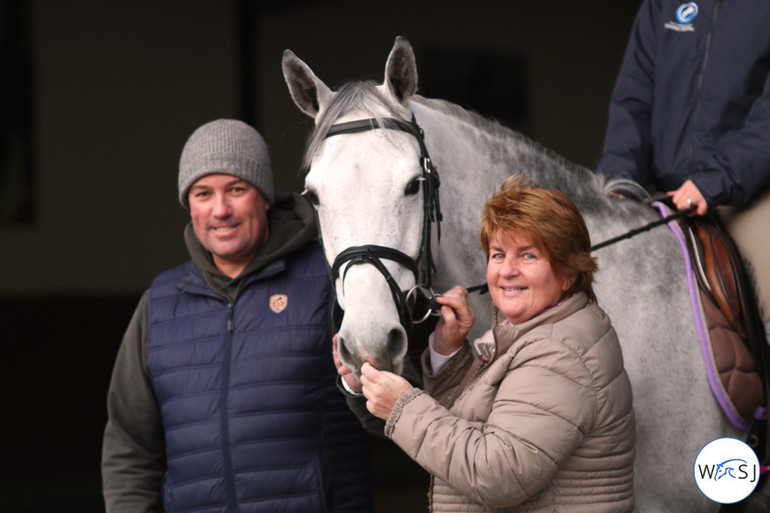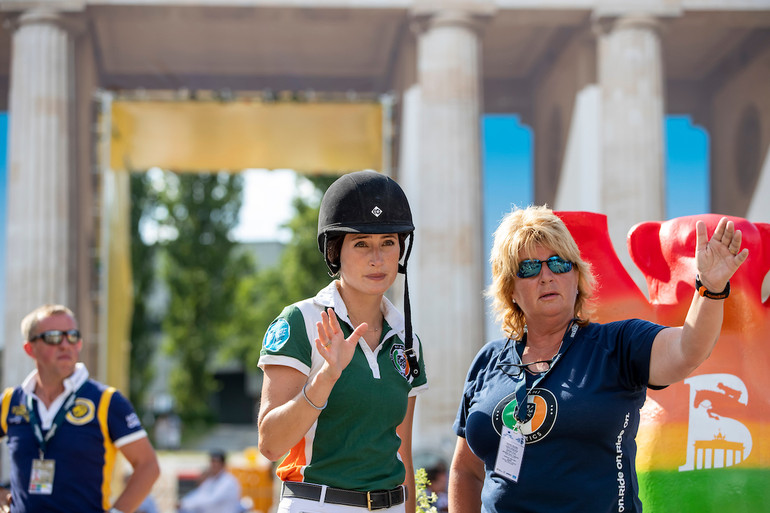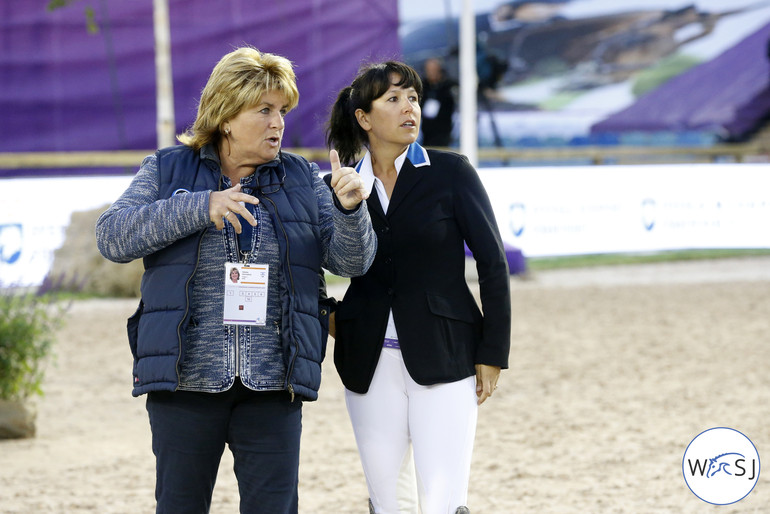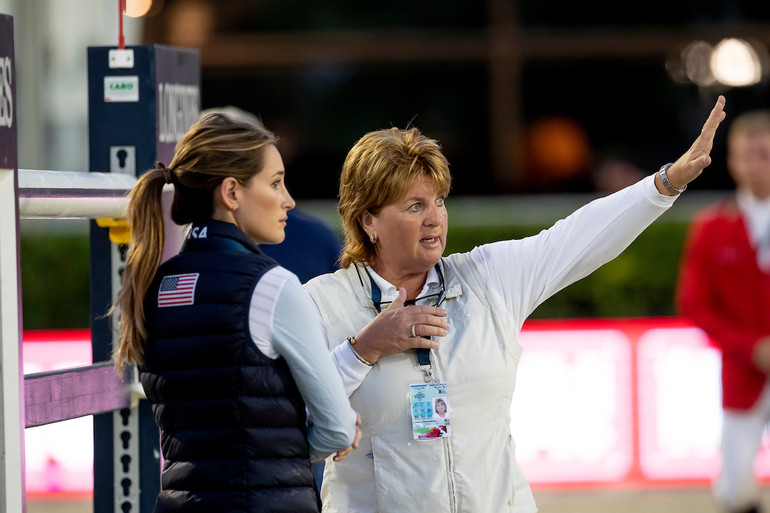Text © World of Showjumping by Nanna Nieminen
After years of competing at the very top of the sport, a skiing accident forced Helena Stormanns to shift from a successful career as a professional showjumper to fulltime trainer. Her students now include professionals such as Jessica Springsteen, William Whitaker and Emil Hallundbaek, as well as amateur riders such as Mary Kate Olsen and Monica McCourt – whose Rushy Marsh Farm horses Helena also manages. When not with her students, Helena is busy coaching her youngest son Tony who has been bitten by the showjumping bug too.
Helena has a no-nonsense, straight-forward training philosophy. “I don’t like quick results that you can’t sustain,” she says. “I like to follow the classics, I like my students to ride well. I don’t like what I call ‘trick riding’ – where people just really scratch the surface, when they have not gone all the way from the bottom. I like everything to be really correct.”
In order to learn, Helena believes that failure is a better teacher than success. “We need success, but sometimes we need to see that a very good round with four faults is better than a scrappy clear round,” she explains. “I analyse the faults in great detail. I watch the rounds together with my students. Why did the fault actually happen? You learn from mistakes. We go into the details on why things happened and then work through it. If everyone jumps clear all the time, they don’t go deep enough.”
“Long term, you need to have a solid base where the horse and the rider are really going well together,” Helena says when talking about her training philosophy. “I don’t change and fiddle around with bits, but I have a strong opinion that if a horse is not able to produce consistent clear rounds you have to change something until you achieve that. I believe in consistency more than anything else.”
Helena believes that most of the time, success boils down to correct flat work. “Many horses aren’t balanced enough on the flat and that is why I put a lot of emphasis on the dressage work,” she says. “Over the modern courses today, the horses have to be really quick to respond to the rider’s aids. They have to shorten when you touch the reins, they have to go when you put your leg on,” she explains. “And that you only fix on the flat, you don’t fix that while jumping.”
Helena also believes that a positive mind benefits the horses. “I am a positive person. I don’t like negative people around me,” she says. “I believe that you transmit positive thoughts to your horse. By nature, horses love to run and jump. They also need forward movement to jump. A loose horse on a field is not going to walk to the fence and jump over it from a standstill. It will walk away, turn, break into a good forward canter, it won’t get too close to the fence, and it will jump out of the field. A horse is a forward, free moving animal and that is the way you should think about riding,” Helena says. “I like control, I like the horse to be responsive, but I like forward riding. It is not about being flat and out of control, it is about being controlled and then riding forwards.”
When meeting a new student, Helena has a few favourite exercises she uses to see what level they are on. “If someone comes to me new, usually I can take them apart in minutes on the flat. If I ask them to do extended counter canter – usually that falls apart. If I ask them to do flying changes down the centre line instead of across the diagonal, that often also falls apart,” she says. “It is really simple, actually. If a horse is not in good balance, it won’t jump consistently.”
Even though Helena is not competing herself anymore, she still rides a lot on the flat. “And when I buy a horse, I always ride it and I always jump it,” she adds. “It is my golden rule – I think I have a relatively good feeling for scope and a good canter stride. You cannot live in this sport with a bad canter. A horse has to have a good canter.”
“Great horses can be made to a certain extent, but great horses are actually born,” Helena continues when speaking about spotting talent. “You cannot make them great – you can make a good horse a great horse, but you cannot make a bad horse a great horse. So, you have to choose the right horses.”
“Today, the breeding of horses is exceptional. I really have to say that I am so grateful to the breeders who persevere and might get a lot of failures on the way, but if we don’t have breeders coming through with these numbers we are never going to have great horses,” she says.
“Actually, the horses have changed less than people would like to tell you,” Helena continues. “They might have more blood than they used to have, and they are maybe better than they used to be. But the horse itself hasn’t really changed that much: It still needs good feeding, good riding, a good blacksmith, good veterinary care, it needs patience and understanding. It needs perseverance, good flat work – those things have always been necessary. The sport has gotten faster and the jumps have gotten lighter, but so have the horses. In actual fact, the fences, the material we jump these days is just more fitting to the horses we have today.”
When it comes to the riders, Helena has a long list of the ingredients needed to succeed. “We don’t need to talk about talent, that is obvious. We don’t need to talk about perseverance, you definitely need that,” Helena says. “I think it is the ability to get up every day, to start up fresh and fight. Because the one thing that really shows in all the top riders, is that they are all fighters. They never flinch when they have been defeated. You cannot be proud in this sport, you have to be humble and you have to stay humble, every single day. You just need to get up and work for it,” Helena continues. “It is a lot about money, but there are still riders who come from very humble backgrounds, who are great riders and will continue to be great riders, because they have what it takes.”
Horsemanship is a factor that Helena highlights when talking about great riders. “If you look to Steve Guerdat, the number one in the world at the moment, his father was a great rider. If you look at Martin Fuchs, his father was a great rider too. It is not by accident that these guys are the riders that they are. It is because horsemanship has been instilled in them at a very early age. Even now, Thomas Fuchs is with his son every step of the way. I cannot emphasise enough the importance of horsemanship. And it is not about buying a new product, or trying a new vitamin, it is about old-fashioned horse care being done in the right way. A good blacksmith, good riding, decent veterinary care. And you have to give the horses patience, you have to wait for a horse to develop. That’s it.”
“I think you learn about horsemanship every day,” Helena continues. “I think that if you are a good horseman, you are wide open to learning something new every day. You have to have a depth of knowledge, however I think you also have to be prepared to test the waters. You have to be prepared to step back and say, ’we tried something new there, but it doesn’t work.’ I think it is a legacy, to pass the horsemanship on to the next generation. It is going to die out otherwise. The knowledge I was lucky enough to gather over years working with really experienced people, I am very thankful for that now.”
“I would like the sport to continue to develop in a controlled environment,” Helena says when asked how she sees the future of the sport. “I would like those who ride well to still be the best in the world and not just the people who want a quick result. I think it is important that the younger riders look up to the great riders who have ridden all their lives – like Nick Skelton, Eric van der Vleuten, Eric Lamaze, to name a few – and learn from them.”
“In the general direction that the sport is going, I hope the right people are there to keep control of things,” she says. “I hope people who are idealists are doing the right thing for the sport, and not the people who are doing it for their own gain or for the wrong reasons. We stand and fall with the horse. It is all about the horse. It is not about riders, or points, or money – it is all about the horse.”
“I love this sport. I love it more than anything else – expect my family of course,” Helena smiles when asked about her motivation. “It motivates me every day, watching great riders and great horses – I love great sport. I get more pleasure now from training and helping my students succeed than I did in the end when I was riding. When you have ridden for 30 something years, you don’t get stale – but every week is a kind of a repetition. You go to a show, you wait three to four days for the Grand Prix – your only really important class – and then if you have one down, you have blown your whole week. Whereas if you train people, you can teach them something every day.”
With a positive mindset and the eyes on the future, what are Helena’s goals for her students we wonder? “On the podium at the Olympics,” Helena closes off with a smile.
No reproduction without permission, copyright © World of Showjumping












